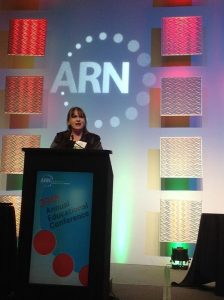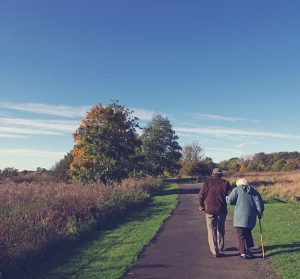The Role of the Rehabilitation Nurse
You may have heard of rehabilitation nursing, but are you familiar with what rehabilitation nurses do and their essential role in health care? According to the Association of Rehabilitation Nurses (ARN), there are four major domains within the new competency model for professional rehabilitation nursing (ARN, 2016) that can help us understand what rehabilitation nurses do. In this blog, we will look at the ARN model from a layperson’s viewpoint to help explain the role of the rehabilitation nurse. Rehabilitation nurses:

Promote successful living
Rehabilitation nurses do not only care for people, but they promote health and prevent disability. This means that rehab nurses engage in activities that help patients, families and communities stay healthy. Proactively, you might see rehab nurses helping with bike safety (such as promoting the wearing of helmets), car seat fairs (to keep children safe from injury), or stroke prevention through community screenings and teaching about managing risk factors. As rehab nurses, we also help patients towards self-management of existing chronic illness or disability, teaching them how to be co-managers with their health providers so they can maintain independence and have a good quality of life. Another key activity is facilitating safe care transitions. This means that rehabilitation nurses have a special skill set to know which setting of care is best for the patient to move to next and how to make this happen smoothly. For example, if Mrs. Smith has had a stroke and finished her time in acute rehabilitation in the hospital, but she lives alone and is not quite ready to go home, what is the best care setting or services for her to receive the help she needs? Many errors, such as those with medications, happen when patients go from one place to another in the health system. Rehabilitation nurses can help persons successfully navigate these complexities and be sure that clients get the continuity of care they need and deserve.
Give quality care
The interventions or care that rehabilitation nurses provide to patients and families is based on the best scientific evidence available. Part of being a rehab nurse is staying current on the latest technology, strategies for care, and best practices. This is to ensure that all patients receive the highest standard of care possible. We stay current in many ways, including reading journal articles, attending conferences, obtaining continuing education, and maintaining certification in rehabilitation. Research shows that having more certified rehabilitation nurses on a unit decreases length of stay in the hospital. In addition, all of rehab care focuses on the patient and family as the center of the interdisciplinary team. To this end, rehabilitation nurses teach patients and families about their chronic illness or disability across many different areas including: how to take medications; managing bowel and bladder issues; preventing skin breakdown; dealing with behavioral issues that might be present with problems such as brain injury or dementia; coping with changes from a disabling condition; sexuality; working with equipment at home; and ways to manage pain.
Collaborate with a team of experts
Rehabilitation nurses are part of an interprofessional team of physicians, therapists, psychologists, nutritionists, and many others who work together for the best patient outcomes. For persons who have experienced a catastrophic injury or illness, the work of this team of experts sharing common goals will provide the best care, and rehab nurses are the ones who are with the patient 24/7 to coordinate this process. Through effective collaboration, excellent assessment skills, and communication with the rest of the team members, rehab nurses ensure that patient and families are getting well-coordinated care throughout the rehabilitation process. Remember that rehabilitation takes place in many settings, whether on the acute rehab unit, in skilled care, long-term care, or the home. The nurse’s role is to be sure that the holistic plan of care is followed by all staff and that the physicians overseeing medical care are continually informed of patient progress for the best decision-making possible.
Act as leaders in rehabilitation
Not only do rehabilitation nurses provide direct patient care, they are also leaders in the rehabilitation arena. You might be surprised to learn that rehabilitation nurses advocate at the highest level for legislation surrounding funding and policy for those with disabilities and chronic illness, talking with Senators and Congressmen about key issues. ARN has professional lobbyists that continually watch health policy movement in Washington and keep rehab nurses informed. Rehab nurses help patients to advocate for themselves in holding government and communities accountable for needed care services. Lastly, rehab nurses share their knowledge with others. This is done in a variety of ways through conducting and publishing research, presenting at conferences, serving on local and national committees, and serving in public office. All of the leadership activities done by nurses in rehabilitation are to promote the best quality of care for patients with chronic illness and disability.
Quick Guide to Yoga for Senior Citizens
 Are you on the hunt for low impact exercise ideas that will help lower your risk for common killers like heart disease? If you have been interested in yoga but hadn’t worked up the nerve to “hit the mat” yet, don’t miss this quick guide:
Are you on the hunt for low impact exercise ideas that will help lower your risk for common killers like heart disease? If you have been interested in yoga but hadn’t worked up the nerve to “hit the mat” yet, don’t miss this quick guide:
What is Yoga for Seniors?
Yoga at its core is an ancient practice in breathing, stretching, meditation, and guided poses. Originating in eastern culture, yoga made its way to the U.S. in the late 20th century, building quite a following across the country as different modalities and styles were developed and specialized studios popped up in more and more places.
Yoga has been adapted for seniors specifically by incorporating more seated movements for those with mobility issues, as well as gentler and more educated approaches to limit joint stress and other common age-related ailments. Common yoga styles for seniors include:
Chair yoga – practiced entirely with the use of a chair, either to sit on or support yourself with, this type of yoga incorporates poses that are modified for seniors who cannot bear weight for long periods of time on their legs.
Water yoga – yoga in a pool is the name of this style’s game and offers a weightless, low-impact practice that is hard to find anywhere else.
Restorative yoga – spend extended periods of time practicing stillness and aligning the body and mind in this yoga style that embraces mental wellbeing.
What are the Benefits of Yoga for Seniors?
In addition to offering generous physical exercise for seniors, routine yoga practice also touts a handful of health benefits including:
Weight management
Pain relief
Stress relief
Social interaction
Lowered blood pressure
Joint mobilization
Skin rejuvenation
Better sleep
Senior yoga can be adapted for older adults with a range of ailments including arthritis, diabetes, mobility issues, and even Alzheimer’s.
Where Can I Find a Senior Yoga Class?
Because of the continued boom of the retiree demographic, more and more yoga classes are being offered to seniors in a variety of environments. You can look for senior classes at your area senior or community recreation center as well as at boutique yoga studios, fitness gyms, health clubs, and even within your own retirement community.
If you would rather see what senior yoga is all about at home, try streaming free instructional yoga videos online either on your computer, tablet, smartphone, or smart TV. You can conduct a quick search for “senior yoga tutorial” on Youtube.com or check sites like DoYogaWithMe.com.
How to Make a Smooth Transition for Your Older Adult Loved One Who’s Moving In
Having an older adult loved one move in with you can be an overwhelming process for both of you, but many Americans are finding it to be the more economical choice. Given that Where You Live Matters asserts that assisted living can cost anywhere from $1,000-$4,000 each month, you might be looking for ways to avoid spending such sums, which can quickly add up.
When one of your family members becomes ill or can no longer afford to live in their own home, asking them to come live with you is a big responsibility.
Not only do you need to consider your loved one’s health needs, but your home may need to be modified, as well. Being a caregiver is a demanding job, but ultimately, many people find that it’s one they are willing to perform if it means their loved one is safe and happy.
Below, Senior Care Central goes over some of the best tips on how to create the perfect environment for your elderly loved one, rather than having your story be one of frustration.
Take a look at your home
No matter what sort of home you live in, you may have some modifications to do before your loved one can move in. Steps on the front porch may require a ramp; bathrooms will need to be fitted with non-slip rubber mats on both the floor and in the tub, and a shower stool and/or grab rail should be installed as well.
As Nationwide explains, extra lighting can also be added to help accommodate those with vision impairments and will go a long way toward preventing falls; throw rugs should either be well-tacked down or simply removed, as they are a trip hazard. Items in the kitchen should be well organized and perhaps even clearly labeled, and cleaning supplies should be kept well away from food items.
In addition to indoor hazards that need addressed, survey the outside of the home to determine whether potential risks should be dealt with. Uneven or cracked walkways should be leveled off or replaced, and old or damaged trees and limbs should be removed.
Even if there are no extra modifications to make, you’ll still need to walk around your home and make a good plan. For instance, if you have stairs in your home, it makes sense to give a ground-floor room to your loved one. Clutter should be removed from walkways and door handles should be easy to grasp. If your loved one suffers from a medical condition — such as Alzheimer’s — which may leave them disoriented or prone to wandering, you may need to consider installing motion sensor alarms on the doors.
You can also allow your loved one to add their own personal flavor to their new space. A quick way to spruce up any room is with a fresh coat of paint or wallpaper. You can find custom wallpaper to suit their particular taste in design, texture, and color schemes. There are scores of options to choose from, including handy no-mess removable wallpaper that can be repositioned or repurposed for another room.
Consider their legacy
We all want to leave something meaningful behind, and many older adults have a will or other legal document stating their intentions for their estate. However, it’s a good idea to make sure they are well taken care of when it comes to their property and belongings. Depending on which state you live in, there may be different laws regarding transferral of assets, so do some research and, if necessary, hire a lawyer to help your loved one get the most out of their decision.
Think about care options
If your loved one has medical needs, it may be necessary for you to spend time at home caring for them. If this isn’t possible, consider hiring a home health assistant to come and relieve you during the day. A qualified professional can give you peace of mind while you’re at work or taking care of other responsibilities, and you’ll know your loved one is receiving the best care.
Practice self-care
Don’t forget to take care of yourself. It can be an overwhelming, stressful (physically and emotionally), and demanding job to look after an older adult. Be sure to take a little time for yourself every day to do something relaxing, something that puts you in a good state of mind.
It can be difficult to see a loved one go through health issues, and some caregivers find they need to speak to a therapist or support group to get through it. Remember that you never have to do something like this on your own.
Guest Blog: How Seniors Can Reduce Financial Stress
Anxiety and worrying about financial problems is a common issue that seniors often face. Obviously, finding a reliable stream of income after retirement is not easy.
Well, one way to reduce mental stress is to visit retirement locations. Another method to alleviate financial problems is to invest in gold bullions at a young age by getting them from Gold Bullion Australia.
Let’s discuss some other techniques to cope with financial stress and live with a mind free from any worries.
Think Positive
Positivity is the key to bringing a healthy change in your life. If you are surrounded with negativity, either in the shape of people or in the form of thoughts, you cannot work on anything without stressing out.
Although it can be difficult to ignore or put your financial problems aside, you can adopt an optimistic approach every time you think about your economic condition.
Define a Budget
Emphasizing on a budget might look like adding more worries to your list, but it is an effective way to get a control on your financial stress. Defining a fixed amount will help you to decide how and when to spend cash.
A budget maintains a balance between savings and spending. When the amount you spend significantly limits the amount you save, you can cut down your budget.
Initially, it will be difficult to make a budget plan because it is not easy to determine how much to save and how much to spend. Once you get a grip of your financial plan, you can easily allocate your budget.
Start by saving on a small scale, and then each month cut down your spending. When you find a right balance, define a budget plan and follow that every month.
An Emergency Fund Can Come in Handy
The money that you set aside for emergency situations and unexpected accidents or incidents is an emergency fund. Allocate a fixed amount to put in the emergency fund box and don’t open that box to take out money until you really have a financial emergency.
This is an effective method to cope with financial stress since you know that you have some spare cash for an unexpected moment.
Although it is not easy to set money aside for an emergency fund, you should really adopt this technique to get out of any trouble in future without asking for monetary help for others or taking bank loans.
Getting Financial Help from Others
In case you are not able to handle your financial problems in spite of having an emergency fund, you might need help from others.
A bank loan or borrowing some money from your friends and family can work in this situation. Keep in mind that a bank loan has to be paid back with interest, while you might not need to pay extra money to your loved ones. So, choose wisely to avoid any financial stress in future.
7 Craft Projects to Bring You Joy
Getting into crafts is a great way to focus your mind and do something that brings you joy. There are so many different crafts that you can do, and even if you are on a budget, you will have no trouble finding a craft that brings you happiness.
1. Soap Making
Soap making is an up-and-coming craft that allows people to create their own handmade soap. There are many different designs, shapes, and more that you can get into with soap making. You can make soap from scratch, or you can get a kit that will give you all the ingredients to make your first batch of soap yourself. As you get more experienced, you can even sell your soap and learn how to create other bath and beauty products.
2. Wood Working
Woodworking has been a popular hobby for centuries. You can create so much wood. From furniture to statues, to even cutlery, you are sure to find something that you can make and enjoy. It is important that when you do this craft, you have all the proper tools for the job like a scroll saw. This will help to ensure that you can create amazing wood pieces that you can sell or just use for yourself. If you are unsure where to begin with woodworking, you should purchase a book on the craft and study it. You may also want to check with your local community college. Some colleges hold woodworking classes to teach about this great craft.
3. Plastic Canvas
Plastic canvas crafts are awesome crafts that you make with yarn and canvas. Many books can teach you how to make different things like tissue holders, magnets, and more. You can also watch various videos online for inspiration.
4. Resin Making
Resin making is gaining in popularity and is a super fun craft. With resin, you mix up the components, and then you mold them. You are not just limited to jewelry. With resin making, you can make mats, cups, picture frames, phone cases, and more. If you are new to resin making, you can watch videos that show you the entire step-by-step process.
5. Candle Making
Candle making is another fun craft that can bring you joy. You can find candle-making kits that will take you through the step-by-step process, or you can purchase molds and start the process yourself. You can also purchase many books and watch videos online about how to get started with candle-making. An up-and-coming craft with candle making that is gaining in popularity is carved candles. Carving unique designs in candles can be very satisfying and bring you joy.
6. Crocheting
Crocheting is an easy craft that uses yarn and needles to create beautiful pieces of work. When you think about crocheting, you will probably be thinking about just blankets. While it is true you can make beautiful blankets with crocheting, you can also create a wide variety of other things as well. For example, many people have branched into making stuffed animals with crocheting. This art, known as amigurumi, can help you to create unique animals for loved ones and to sell. If you are new to crocheting, consider getting books, and watching videos online.
7. Sewing
The possibilities are endless when you get into sewing. You can learn to make blankets, or you can even learn to make quilts. Another option is to learn how to sew your own clothes or baby doll clothes. If you are new to sewing, you will first want to learn how to hand stitch, and then you can move on to learning how to use a sewing machine. If you are curious as to what crafts you might make, you can look online for inspiration or go to your local craft store to find inspiration.
Crafting is therapeutic for many people and can bring you peace and joy. Many doctors and therapists now recommend that people should get into a craft to help ease anxiety and depression. If you want to have more joy in your life, consider getting into one or more of these crafts. You will be amazed at how having a craft to do focuses your brain and helps you throughout your day.



